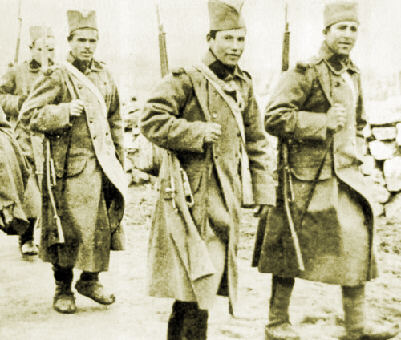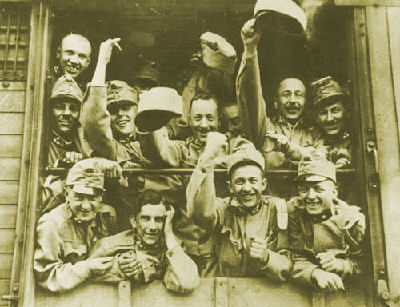Invading Central Powers Cross Into Serbia
October 1915
By Matt Church
University of Louisville

Serbian Soldiers 1915
In the autumn of 1915 the Serbian Army was still a participant in the First World War. The Serbian Army was underestimated in the early portion of the war and faced an invasion by Austro-Hungarian forces under Marshal Conrad. The Austro-Hungarian forces invaded Serbia from the west and were intent upon destroying the Serbs and exacting revenge for the assassination of Archduke Franz Ferdinand. This quick victory was not in the making, and the Serbian army under Radomir Putnik drove back an Austro-Hungarian force at the River Vardar in August of 1914 (Keegan, 1995). Even after the capture of Belgrade the Serbian forces were able to rally and drive the Austro-Hungarian forces from Serbian lands in December 1914. This initial victory allowed for the continued Serbian presence in the war and was aided by the participation of Serbia's Russian allies. Serbia would be free from invasion until 1915, but the results in 1915 were far different.
The initial Serbian victories were obscured by the realization that Serbia stood little chance against the full power of the German and Austro-Hungarian armies. As historian John Keegan noted, Serbia's survival was predicated on the preoccupation of the Central Powers by other combatants (Keegan, 1995). The Allied assaults at Gallipoli and Salonika in 1915 were partly designed to relieve Serbia and these operations, when coupled with the Italian entry into the war, provide a certain respite for Serbian fortunes. Serbia's fate darkened when Bulgaria joined the Central Powers in 1915.

Austrian Troops — Happier in 1915 Than 1914
The Central Powers planned to decisively defeat Serbia and open communications with Istanbul via Belgrade (Keegan, 1995). The Serbs ordered a general mobilization and still had forces arrayed in the northern and eastern parts of their country. The placement of the Serbian forces had changed little since the initial Austro-Hungarian attack in 1914.
The German plan called for German and Austro-Hungarian forces to attack from the north and Bulgarian forces to invade Serbia from the east. Serbia had 11 weak divisions in the field against ten German divisions, six Bulgarian divisions, and seven Austro-Hungarian divisions (Keegan, 1995). Also, German artillery outnumbered Serbian artillery by a 4:1 margin (Keegan, 1995). The German and Austro-Hungarian forces began bombarding the Serbian forces on 5 October 1915 and bridged the Sava and Danube rivers on 7 October (Keegan, 1995). Belgrade fell on 9 October, and Bulgaria invaded from the east on 11 October 1915.
The Serbian Army in Retreat
The goal of the assault was to surround or pin down the Serbian forces, but the ruggedness and determination of the Serbs allowed for their survival. The Serbian army and thousands of civilians marched through Montenegro and Albania, eventually being transported by Italian ships to Corfu. Of the 200,000 who made the march with the Serbian forces, only 140,000 survived the march to Albania (Keegan, 1995). Austro-Hungarian forces took possession of Montenegro, and Serbia was effectively removed from the war. The resilience and determination of the Serbian forces in World War I is to be admired. While the Serbians were marching across the harsh Montenegrin mountains, Allied forces at Salonika were stunted by Bulgarian forces. Every Allied attempt to relieve pressure on Serbia met with failure, and the result was Bulgaria's entry into the war on the side of the Central Powers and the removal of the Serbian army from the Balkan theater.


I believe without German troops Serbia would have survived Austro-Hungarian and Bulgarian forces. The majority of the troops were and most of the artillery were German. I think given the number of French and British troops in Salonika, better use could have been made by evacuating Salonika and move to Albania where the Italian Navy and Army could also support the Serbs.
ReplyDelete